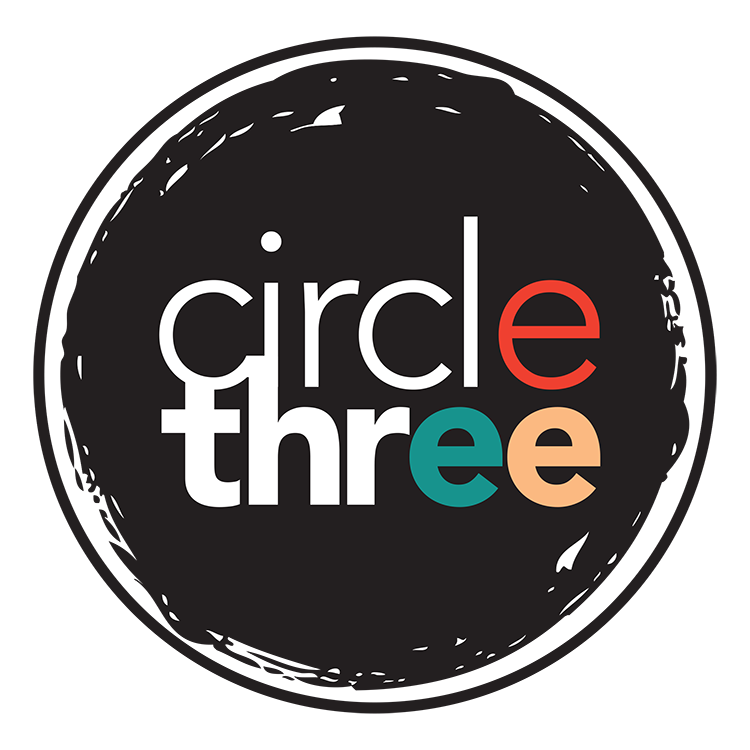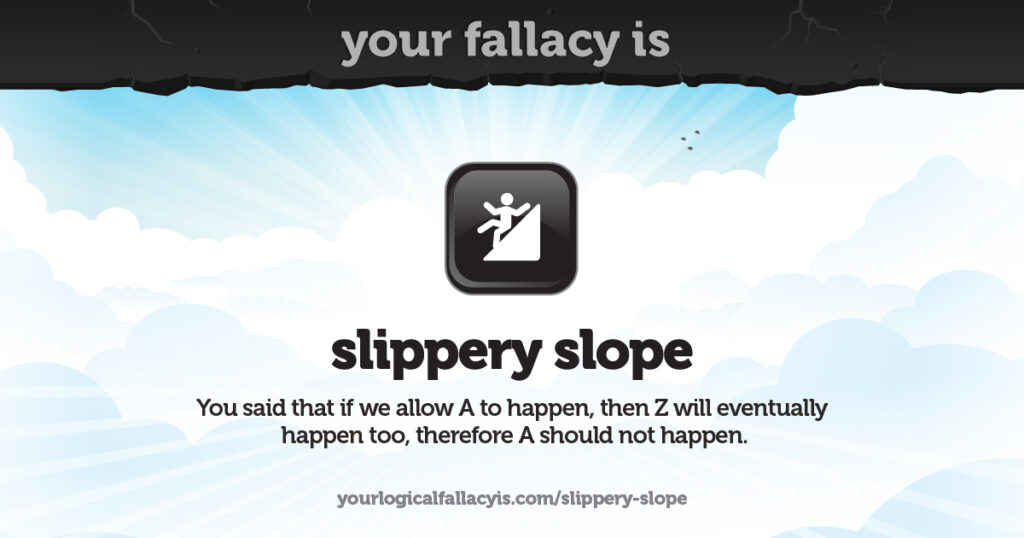This is one part in a series on Cognitive Biases and Logical Fallacies in marketing. Read more here.
The slippery slope is a logical fallacy that suggests that a particular course of action will lead to a chain of events, often negative or undesirable, without sufficient evidence or reasoning to support this progression. It assumes that one action will inevitably lead to a series of increasingly severe consequences, creating a slippery or uncontrollable descent.
In essence, it’s like saying if A happens, then B will follow, which will lead to C, D, and so on, ultimately resulting in an extreme or unfavorable outcome. However, this argument lacks substantial evidence or logic to prove the direct causal link between each step in the sequence.
While it’s important to consider potential consequences of actions, the slippery slope fallacy exaggerates these consequences without proper justification, often to dissuade or promote a specific viewpoint without solid reasoning.
Slippery Slope’s Effect on Business
In business and marketing, the slippery slope fallacy can have several implications:
Internal Stakeholders:
- Decision-Making: Within a company, this fallacy can affect decision-making processes. If one negative outcome is exaggerated as leading to a series of catastrophic events, it might prevent innovative or risk-taking decisions, hindering progress.
- Risk Aversion: Teams might become overly cautious, fearing that one misstep will lead to an uncontrollable series of failures. This can stifle creativity and experimentation, hampering the pursuit of potentially beneficial strategies.
External Customers:
- Fear-based Marketing: Companies might use this fallacy in their marketing strategies by employing fear tactics. They could suggest that not using their product or service will lead to a domino effect of negative consequences.
- Exaggerated Outcomes: When promoting products or services, companies might exaggerate the consequences of not choosing their offering. This can create a sense of urgency or fear to drive sales.
Relationship Building:
- Trust and Credibility: Overusing the slippery slope fallacy can undermine trust. If customers or stakeholders perceive that a company is exaggerating consequences without solid evidence, it can erode credibility.
- Ethical Concerns: Continuously painting exaggerated negative outcomes could be seen as manipulative or deceitful, potentially damaging the relationship between a company and its stakeholders.
Marketing Strategy:
- Long-Term Planning: Overreliance on the slippery slope fallacy might hinder long-term strategic planning. It could lead to short-term, reactionary decision-making rather than considering a comprehensive, sustainable marketing approach.
- Messaging and Communication: If a company’s marketing messages are consistently based on exaggerated consequences, it might alienate customers who see through these tactics and prefer more honest and transparent communication.
Mitigating the Impact:
- Evidence-based Reasoning: Encouraging evidence-based decision-making and marketing strategies can mitigate the impact of the slippery slope fallacy.
- Transparent Communication: Building trust through transparent and honest communication helps establish credibility and a stronger relationship with both internal stakeholders and external customers.
In essence, while the slippery slope fallacy might be used consciously or inadvertently in business and marketing, its overuse can have adverse effects on decision-making, relationships, and overall brand perception. Encouraging critical thinking and evidence-based reasoning can help mitigate its impact in these domains.
Let’s Fix It
In the waste, recycling, or sustainability sectors, it’s crucial to maintain credibility and trust, especially when communicating about crucial issues like environmental impact. Here’s how companies in these sectors can avoid the slippery slope in their marketing plans:
1. Focus on Tangible Results:
Emphasize real, measurable outcomes of sustainable practices rather than using exaggerated claims about potential catastrophic consequences. Highlight concrete achievements, like the amount of waste diverted from landfills or the reduction in carbon footprint.
2. Use Data and Evidence:
Back up marketing claims with data and evidence. Utilize specific metrics, studies, or certifications to support statements about environmental impact or sustainability achievements. Transparency about methodologies and results is key.
3. Avoid Fear-based Tactics:
Steer clear of fear-based marketing that relies on exaggerating the negative consequences of not engaging in sustainable practices. Instead, focus on positive outcomes and the benefits of sustainability without resorting to alarmist language.
4. Educate and Inspire:
Educate consumers about the importance of sustainability and recycling without resorting to extreme scenarios. Inspire action by highlighting the positive effects of individual and collective efforts toward sustainability.
5. Provide Clear Information:
Offer transparent and clear information about the company’s sustainability initiatives, goals, and the steps taken to achieve them. Communicate progress honestly, including both successes and challenges.
6. Collaborate and Showcase Partnerships:
Highlight partnerships or collaborations with other organizations, governments, or communities that contribute to sustainable practices. This demonstrates a collective effort and commitment to sustainability.
7. Avoid Overpromising:
Avoid making exaggerated claims or promises about the impact of specific products or services on the environment. Be realistic about what can be achieved and focus on continuous improvement.
8. Engage in Ethical Marketing:
Ensure marketing materials and campaigns align with ethical standards. Avoid using misleading imagery or language that could be perceived as greenwashing or manipulation.
9. Encourage Responsible Consumer Behavior:
Encourage responsible consumption and recycling habits without resorting to extreme or alarmist messages. Empower consumers with information to make informed choices.
10. Seek Feedback and Adapt:
Be open to feedback from stakeholders and consumers. Adapt marketing strategies based on feedback to ensure that messaging remains accurate, credible, and resonates positively.
By following these practices, companies in the waste, recycling, or sustainability sectors can avoid the slippery slope fallacy and build trust, credibility, and engagement with consumers who are increasingly conscious of environmental issues.
Interested in Learning More?
We’ll cover more cognitive biases and logical fallacies in upcoming blog posts, but if you’re eager to learn more and access free resources, check out School of Thought. If you’re interested in see how Circle Three Branding applies these to your marketing strategy, contact us.

